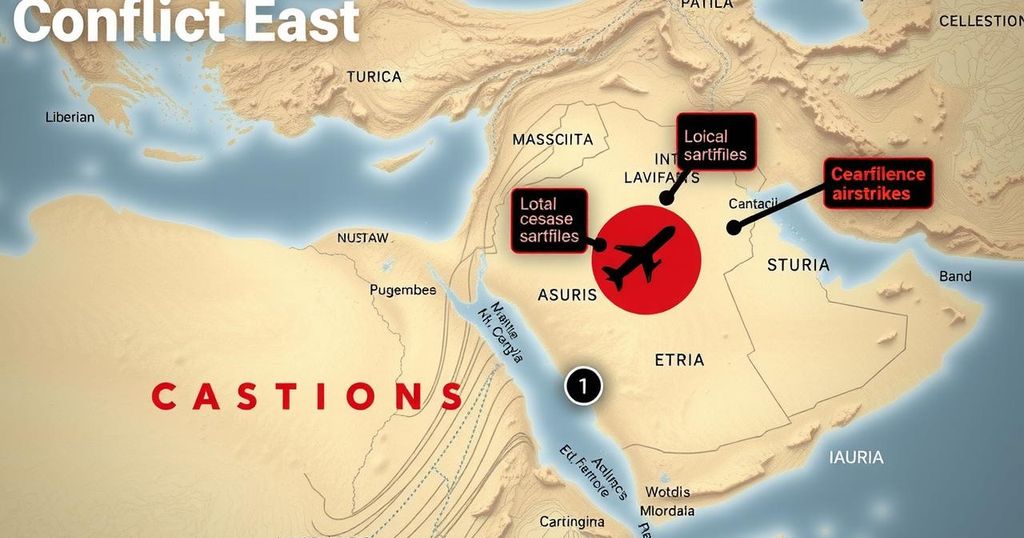Analyzing the Collapse of the Gaza Ceasefire and U.S. Strikes in Yemen

The Gaza ceasefire has collapsed as Israel halts humanitarian aid and escalates airstrikes against Hamas following failed negotiations. In response, the U.S. has launched airstrikes against Houthi forces in Yemen, signaling a strategy focused on pressuring Iran. The lack of a long-term plan for Gaza is evident, while the geopolitical landscape remains complex with challenges to both Iranian stability and potential nuclear agreements.
In recent weeks, the international focus has been drawn to ceasefire discussions regarding Ukraine. However, a ceasefire deal in Gaza, which was facilitated by former President Donald Trump, has deteriorated. Following unsuccessful negotiations with Hamas, Israel halted humanitarian aid and initiated extensive airstrikes in Gaza, resulting in significant casualties.
The resumption of Israeli airstrikes signifies the termination of the temporary ceasefire. Pressure from hard-right elements in Israel’s government has prevented Prime Minister Netanyahu from accepting any significant concessions to Hamas, such as a full withdrawal from Gaza. In light of ongoing hostage considerations and Hamas’s refusal to agree to any significant terms, the conflict has intensified with renewed aerial assaults.
Currently, there is no comprehensive long-term strategy for Gaza. Netanyahu is primarily focused on the immediate retrieval of hostages to appease political pressures. Hard-right factions may envision a military-controlled, depopulated Gaza but such ambitions are on hold amid ongoing violence. Across the West Bank, escalating Israeli military operations may indicate a broader strategy for territorial expansion.
Former President Trump, who previously took credit for facilitating the initial phase of the ceasefire, is likely to respond by criticizing Hamas for the ceasefire’s collapse. His approach appears to shift towards placing blame rather than seeking further peace negotiations. Meanwhile, United States airstrikes in Yemen against Houthi forces are perceived as a strategy to exert pressure on Iran and project strength domestically.
Airstrikes against the Houthis enable Trump to maintain a tough public persona while distracting from domestic challenges. The strikes serve multiple purposes: potentially pressuring Iran ahead of nuclear negotiations, reinforcing Israel’s military advantage in Gaza, and supporting regional allies like Saudi Arabia. This calculated military action intends to deter Houthi aggression in the Red Sea.
Despite the aggression, Iranian responses have been notably subdued, largely due to domestic strife and significant economic challenges. Widespread discontent follows years of economic turmoil, rampant inflation, and government repression against protests. Iran’s regional influence continues to wane, complicating its ability to confront the U.S. militarily.
Regarding a potential new nuclear agreement, some advisors within the Trump administration seem to believe pressure through military action in Yemen could force Iran into negotiations. However, Iranian leaders have dismissed the notion of talks under the current conditions, seeing threats of military action as counterproductive. This increasingly adversarial stance suggests that any prospects of a renewed agreement may remain unlikely if the U.S. continues to rely on coercive tactics rather than diplomatic engagement.
In conclusion, the Gaza ceasefire has officially unraveled, largely due to the political pressures within Israel and the stalled negotiations with Hamas. While there appears to be no long-term strategy for Gaza, the focus shifts towards military operations in the West Bank. Concurrently, U.S. airstrikes in Yemen reflect a dual strategy to maintain regional influence while addressing domestic challenges. Iranian leadership remains resistant to negotiations under coercive conditions, casting doubt on future nuclear discussions.
Original Source: theconversation.com








